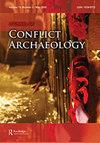The fort in the doctor’s house: using tree-ring growth patterns to discover historic Fort Wayne, Indiana, USA
IF 0.6
0 ARCHAEOLOGY
引用次数: 1
Abstract
ABSTRACT Local Fort Wayne, Indiana (USA) lore says that the Dr. Merchant Huxford House contains timbers from Fort Wayne, the US military outpost constructed in 1794 by General Anthony Wayne. The wilderness fort played roles in Native American and British conflicts and was the genesis for a city with a current population of more than 250,000. The doctor’s residence was built on the outskirts of the young city, but within 0.4 km of the fort site. Accounts contemporary to the house’s construction describe timbers being recycled from the fort for use in new building projects. This article describes the use of dendrochronological methods to establish a construction date for the Huxford House and attempts to confirm or dispel accounts that the house contains recycled timbers from the historic fort. Graphical abstract医生家中的堡垒:利用树木年轮生长模式发现美国印第安纳州历史悠久的韦恩堡
摘要美国印第安纳州韦恩堡当地传说,Merchant Huxford博士住宅内有韦恩堡的木材,韦恩堡是安东尼·韦恩将军于1794年建造的美军前哨基地。荒野堡垒在美洲原住民和英国人的冲突中发挥了作用,是一座目前人口超过25万的城市的起源。这位医生的住所建在这座年轻城市的郊区,但距离堡垒遗址不到0.4公里。与这座房子建造年代相同的描述描述了从堡垒中回收的木材用于新的建筑项目。这篇文章描述了使用树木年代法来确定赫克斯福德之家的建造日期,并试图证实或消除关于该房屋包含历史堡垒中回收木材的说法。图形摘要
本文章由计算机程序翻译,如有差异,请以英文原文为准。
求助全文
约1分钟内获得全文
求助全文
来源期刊

Journal of Conflict Archaeology
ARCHAEOLOGY-
CiteScore
0.80
自引率
50.00%
发文量
8
期刊介绍:
The Journal of Conflict Archaeology is an English-language journal devoted to the battlefield and military archaeology and other spheres of conflict archaeology, covering all periods with a worldwide scope. Additional spheres of interest will include the archaeology of industrial and popular protest; contested landscapes and monuments; nationalism and colonialism; class conflict; the origins of conflict; forensic applications in war-zones; and human rights cases. Themed issues will carry papers on current research; subject and period overviews; fieldwork and excavation reports-interim and final reports; artifact studies; scientific applications; technique evaluations; conference summaries; and book reviews.
 求助内容:
求助内容: 应助结果提醒方式:
应助结果提醒方式:


